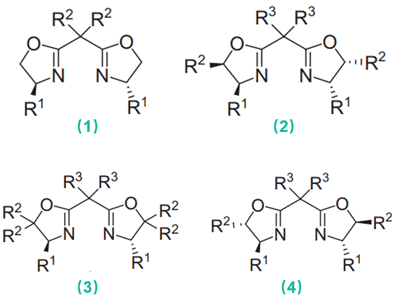| Catalog No. |
Name |
CAS |
Inquiry |
| BCC-03974 |
(S)-3,3'-Dichloro-[1,1'-binaphthalene]-2,2'-diol |
1338475-04-9 |
|
| BCC-03975 |
(R)-3,3'-Dichloro-[1,1'-binaphthalene]-2,2'-diol |
287111-92-6 |
|
| BCC-03976 |
(S)-3,3'-Dibromo-2,2'-bis(methoxymethoxy)-5,5',6,6',7,7',8,8'-octahydro-1,1'-binaphthalene |
|
|
| BCC-03977 |
3,3',5,5'-Tetramethyl-[1,1'-biphenyl]-2,2'-diol |
26567-10-2 |
|
| BCC-03978 |
(S)-3,3'-Bis(3,3-dimethylbutyl)-[1,1'-binaphthalene]-2,2'-diol |
|
|
| BCC-03979 |
(R)-6,7-Diphenyldibenzo[e,g][1,4]diazocine-1,12-diol |
2648055-07-4 |
|
| BCC-03980 |
(S)-3,3'-Bis(4-nitrophenyl)-5,5',6,6',7,7',8,8'-octahydro-[1,1'-binaphthalene]-2,2'-diol |
2129645-35-6 |
|
| BCC-03981 |
(S)-3,3'-Di-9-anthracenyl-5,5',6,6',7,7',8,8'-octahydro-[1,1'-binaphthalene]-2,2'-diol |
2757287-35-5 |
|
| BCC-03982 |
(S)-5',5'',6',6'',7',7'',8',8''-Octahydro-[1,2':4',1'':3'',1'''-quaternaphthalene]-2'',3'-diol |
2247513-10-4 |
|
| BCC-03983 |
(S)-3,3'-Di([1,1'-biphenyl]-4-yl)-5,5',6,6',7,7',8,8'-octahydro-[1,1'-binaphthalene]-2,2'-diol |
2757287-34-4 |
|
| BCC-03984 |
(S)-3,3'-Bis(perfluorophenyl)-[1,1'-binaphthalene]-2,2'-diol |
877304-22-8 |
|
| BCC-03985 |
12,13,15,16,18,19,21,22,24,25-Decahydrodinaphtho[2,1-q:1',2'-s][1,4,7,10,13,16]hexaoxacycloicosine |
41051-90-5 |
|
| BCC-03986 |
((4R,5R)-2,2-Dimethyl-1,3-dioxolane-4,5-diyl)bis(bis(3,5-diisopropyl-4-methoxyphenyl)methanol) |
2828439-65-0 |
|
| BCC-03987 |
1,2-Di-p-tolylethane-1,2-diol |
24133-59-3 |
|
| BCC-03988 |
((4R,5R)-2,2-Dimethyl-1,3-dioxolane-4,5-diyl)bis(bis(4-(tert-butyl)phenyl)methanol) |
163726-72-5 |
|
| BCC-03989 |
(1R)-5-Bromotricyclo[8.2.2.24,7]hexadeca-4,6,10,12,13,15-hexaene |
37503-79-0 |
|
| BCC-03990 |
1,2-Bis(4-(trifluoromethyl)phenyl)ethane-1,2-diol |
199166-26-2 |
|
| BCC-03991 |
((4R,5R)-2,2-Dimethyl-1,3-dioxolane-4,5-diyl)bis(bis(3,5-di-tert-butylphenyl)methanol) |
871945-77-6 |
|
| BCC-03992 |
(1S)-5-Bromotricyclo[8.2.2.24,7]hexadeca-4,6,10,12,13,15-hexaene |
37503-80-3 |
|
| BCC-03993 |
1,2-Bis(4-fluorophenyl)ethane-1,2-diol |
24133-58-2 |
|
BOC Sciences has developed various types of efficient and highly coordination ability chiral ligands for asymmetric reaction, and further utilizes these ligands to complete the synthesis of chiral compounds. Our chemical engineering and process research departments have dedicated organometallic chemists with extensive screening expertise. In addition, we are equipped with specialized equipment capable of efficiently producing large quantities of chiral auxiliaries and catalysts.
Introduction
Catalytic asymmetric synthesis is one of the most efficient methods for the production of optically active compounds. Among various asymmetric catalyses, transition metal catalyzed reactions have attracted a great deal of attention over the years; many catalyst systems of this class have been developed and some have been successfully applied to the industrial production of useful optically active compounds. Both enantioselectivity and catalytic efficiency are highly dependent on chiral ligands and central metals. Therefore, the design and synthesis of new chiral ligands is a very important research subject. Chiral oxygen-based ligands with chiral backbones have been one of the historic workhorses of asymmetric transition-metal-catalyzed reactions. Currently, chiral oxygen ligands that have been widely reported and applied in industrial production mainly include chiral TADDOLate ligands, chiral BINOL ligands, chiral salen ligands, chiral PHOX ligands and chiral bisoxazolines (Box) ligands.
 Fig. 1. Representative examples of chiral oxygen ligands (John Wiley & Sons, 2011).
Fig. 1. Representative examples of chiral oxygen ligands (John Wiley & Sons, 2011).
Typically, oxygen atoms are mainly coordinated on metal ions with heteroatoms such as nitrogen-, phosphorus-, and sulfur. For example, chiral bisoxazolines (Box) is a typical class of N-O-based chiral ligands, which comprise a class of ligands that figure prominently in metal-catalyzed asymmetric synthesis. The basic design of these ligands includes two oxazoline moieties connected by a spacer unit. The parent bisoxazoline ligands contain a single carbon spacer unit that is generally substituted with two identical substituents. Ligands of this type represent the most prevalent structural motif for the bisoxazolines. In addition, chiral salen ligands are another well-studied class of oxygen-based ligands. The structural properties of chiral salen complexes exert essential influences on their asymmetric catalytic performances. Sometimes a slight structural modification dramatically alters asymmetric induction. Most chiral salen-metal complexes adopt octahedral configuration. Dianionic tetradentate salen ligands bind metalions securely through two nitrogen and two oxygen atoms. Two anionic or neutral ancillary ligands occupy another two coordination sites.
Application
The growing demand in enantiopure compounds for pharmaceutical, agrochemical, perfume and material applications together with new regulatory pressure induced a strategic shift to chiral methodologies and catalysis. Chiral oxygen ligands are very important ligands in organometallic catalysis, and usually they are prepared by resolutions or by using a stoichiometric amount of chiral auxiliaries. Chiral oxygen-based ligands are widely applicable to enantioselective reactions such as aldol reactions, mannich-type reactions, nitroaldol (henry) reactions, nitro-mannich (aza-henry) reactions, friedel-crafts reactions, 1,4-addition, cyclization reactions, rearrangement reactions, and so on.
References:
- Zhou, Q.L. et al. Privileged chiral ligands and catalysts. John Wiley & Sons, 2011.
- Imamoto, T. P-chiral phosphine ligands for transition-metal-catalyzed asymmetric reaction. J. Synth. Org. Chem. Jpn. 2007, 65(11): 1060-1069.
Chiral Technical Information

 Fig. 1. Representative examples of chiral oxygen ligands (John Wiley & Sons, 2011).
Fig. 1. Representative examples of chiral oxygen ligands (John Wiley & Sons, 2011).










